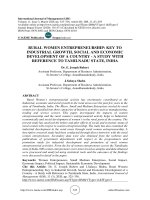Economic growth and economic development 685
Bạn đang xem bản rút gọn của tài liệu. Xem và tải ngay bản đầy đủ của tài liệu tại đây (134.94 KB, 1 trang )
Introduction to Modern Economic Growth
where η ≡ η H /η L and the *’s denote that this expression refers to the BGP value.
The notable feature here is that relative productivities are determined by the in-
novation possibilities frontier and the relative supply of the two factors. In this
sense, this model totally endogenizes technology. Equation (15.27) contains most
of the economics of directed technology. However, before discussing this, it is useful to characterize the BGP growth rate of the economy. This is done in the next
proposition:
Proposition 15.1. Consider the directed technological change model described
above. Suppose that
(15.28)
Ô 1
Ê
(1 ) ( H H)1 + ( L L)1 1 > and
Ê
Ô 1
(1 − θ) β (1 − γ)ε (η H H)σ−1 + γ ε (η L L)σ−1 σ−1 < ρ.
Then there exists a unique BGP equilibrium in which the relative technologies are
given by (15.27), and consumption and output grow at the rate
Ô 1
1 Ê
(15.29)
g =
(1 ) ( H H)1 + γ ε (η L L)σ−1 σ−1 − ρ .
θ
Proof. The derivation of (15.29) is provided by the argument preceding the
proposition. Exercise 15.2 asks you to check that condition (15.28) ensures that
free entry conditions (15.20) and (15.21) must hold, to verify that this is the unique
relative equilibrium technology, to calculate the BGP equilibrium growth rate and
to verify that the transversality condition is satisfied.
Ô
It can also be verified that there are simple transitional dynamics in this economy
whereby starting with technology levels NH (0) and NL (0), there always exists a
unique equilibrium path and it involves the economy monotonically converging to
the BGP equilibrium of Proposition 15.1. This is stated in the next proposition:
Proposition 15.2. Consider the directed technological change model described
above. Starting with any NH (0) > 0 and NL (0) > 0, there exists a unique equilibrium path. If NH (0) /NL (0) < (NH /NL )∗ as given by (15.27), then we have
ZH (t) > 0 and ZL (t) = 0 until NH (t) /NL (t) = (NH /NL )∗ . If NH (0) /NL (0) <
(NH /NL )∗ , then ZH (t) = 0 and ZL (t) > 0 until NH (t) /NL (t) = (NH /NL )∗ .
671









